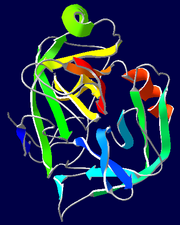Chymotrypsin
Chymotrypsin (bovine γ chymotrypsin: PDB 1AB9, EC 3.4.21.1) is a digestive enzyme that can perform proteolysis. more...
Activation of chymotrypsin
Chymotrypsin is synthesized by protein biosynthesis as a precursor called chymotrypsinogen that is enzymatically inactive. On cleavage by trypsin into two parts that are still connected via an S-S bond, cleaved chymotrypsinogen molecules can activate each other by removing two small peptides in a trans-proteolysis. The resulting molecule is active chymotrypsin, a three polypeptide molecule interconnected via disulfide bonds.
Action and Kinetics of chymotrypsin
In vivo, chymotrypsin is a proteolytic enzyme acting in the digestive systems of mammals and other organisms. It facilitates the cleavage of peptide bonds by a hydrolysis reaction, a process which albeit thermodynamically favourable, occurs extremely slowly in the absence of a catalyst. The main substrates of chymotrypsin include tryptophan, tyrosine, phenylalanine, and methionine, which are cleaved at the carboxyl terminal. Like many proteases, chymotrypsin will also hydrolyse ester bonds in vitro, a virtue that enabled the use of substrate analogs such as N-acetyl-L-phenylalanine p-nitrophenyl ester for enzyme assays.
Chymotrypsin cleaves peptide bonds by attacking the unreactive carbonyl group with a powerful nucleophile, the serine 195 residue located in the active site of the enzyme, which briefly becomes covalently bonded to the substrate, forming an enzyme-substrate intermediate.
These findings rely on inhibition assays and the study of the kinetics of cleavage of the aforementioned substrate, exploiting the fact that the enzyme-substrate intermediate p-nitrophenolate has a yellow colour, enabling us to measure its concentration by measuring light absorbance at A400.
It was found that the reaction of chymotrypsin with its substrate takes place in two stages, an initial “burst” phase at the beginning of the reaction and a steady-state phase following Michaelis-Menten kinetics. The mode of action of chymotrypsin explains this as hydrolysis takes place in two steps. First acylation of the substrate to form an acyl-enzyme intermediate and then deacylation in order to return the enyzme to its original state.
Reference
- Stryer et. al. (2002). Biochemistry (5th ed.). New York: Freeman. ISBN 0-7167-4684-0.
Read more at Wikipedia.org



